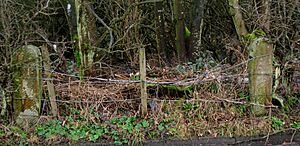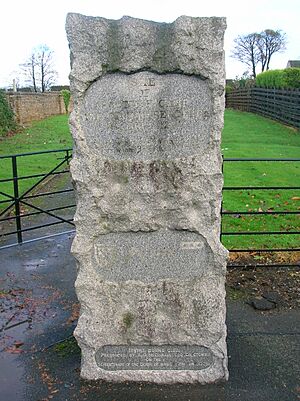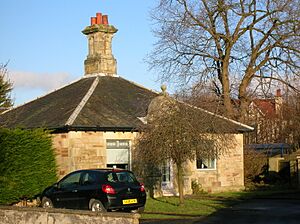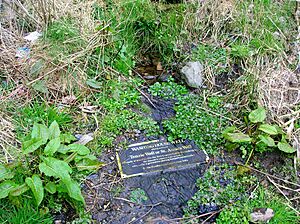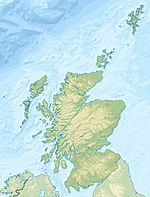Trindlemoss Loch facts for kids
Quick facts for kids Trindlemoss Loch or Scott's Loch |
|
|---|---|
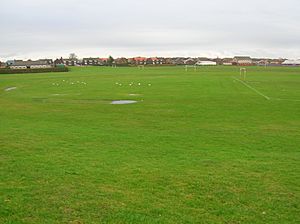
Trindlemoss Loch site
|
|
| Lua error in Module:Location_map at line 420: attempt to index field 'wikibase' (a nil value). | |
| Location | Irvine, North Ayrshire, Scotland |
| Type | Drained freshwater loch |
| Primary inflows | Rainfall and drainage |
| Primary outflows | To the Annick Water |
| Basin countries | Scotland |
| Islands | None |
| Settlements | Irvine |
Trindlemoss Loch, also known as Scott's Loch, was once a large freshwater lake near Irvine, North Ayrshire, Scotland. It was a natural loch, formed in a dip in the land left by glaciers long ago. Over time, the water in the loch was slowly drained away, and by 1691, it was completely gone. Today, the area where the loch used to be is mostly playing fields.
Contents
History of Trindlemoss Loch
Old maps, like Blaeu's map from 1654, show Trindlemoss Loch as two separate lakes. This map was created based on surveys done by Timothy Pont in the early 1600s.
Around 1691, a minister named Rev Patrick Warner bought land in Irvine. This land included Trindlemoss Loch, along with rights to hunt birds and fish there. He also bought nearby meadows. Warner then began the big job of draining much of the loch. Because a man named Provost John Scott used to own the loch, it later became known as Scott's Loch.
In 1763, a common area (land shared by everyone) near the loch was fenced off.
The Treaty of Irvine (1297)
An important historical event, the 'Treaty of Irvine', was signed at Seagate Castle on July 9, 1297. This treaty was between Scotland and England.
In 1297, King Edward I of England sent an army to Irvine. He wanted to stop a Scottish uprising. This uprising happened because Edward I had removed John Balliol from the Scottish throne.
The Scottish army was led by important figures like Robert Bruce and Bishop Wishart. The two armies camped close to each other: the English at Tarryholme and the Scots at Knadgerhill. Trindlemoss Loch lay between them. After a lot of discussion, the Scottish leaders decided to surrender without a fight.
How Trindlemoss Loch Was Drained
The draining of Trindlemoss Loch started as early as the 1500s. A ditch called the 'Gruipe Gutter' was dug to send the loch's water into the River Irvine. The loch's natural outflow (where water usually flowed out) was a small stream that went into the Annick Water.
Patrick Warner, the minister of Irvine, had been sent away to Holland for a time. While there, he learned new ways of draining land from the Dutch. When he returned, he dug ditches, or 'gotts', that connected to a main drain called the 'Minister's Cast'. This drain ran from the north end of the loch area into the River Irvine. This new system worked well, and the older drain, the 'Grip or Gruipe Gutter', dried up. Other people also helped drain the southern part of the loch into the Annick Water. The land that was once underwater became valuable farmland.
In 1682, the Baillie of Irvine, Hugh Montgomery, was paid back for money he spent on digging a ditch that led to the loch.
The Tanzie Well, also known as St Anne's or the Washing House Well, is a natural spring. It flows into the River Irvine near the golf fields. This spring still exists today and is thought to carry water from the old Scott's Loch site.
Watermills Powered by the Loch
Several mills used the water from Trindlemoss Loch to power their machinery. One such mill was Lochmills, built on land belonging to the town at Lochwards. It was powered by the natural flow of water out of the loch. In 1666, Johne Boill was the miller there. However, these mills lost their water power when the loch was drained in the 1690s. Timothy Pont also noted a mill located at the southern exit of the loch in the early 1600s.
Interesting Facts About the Loch Area
In the 1700s, a religious group called the Buchanites were forced to leave Irvine. Some residents threatened to drown them in Scott's Loch. Luckily, the group made it safely to the village of Closeburn.
Images for kids


